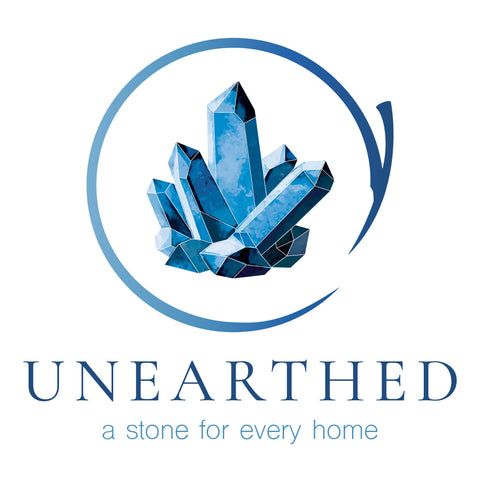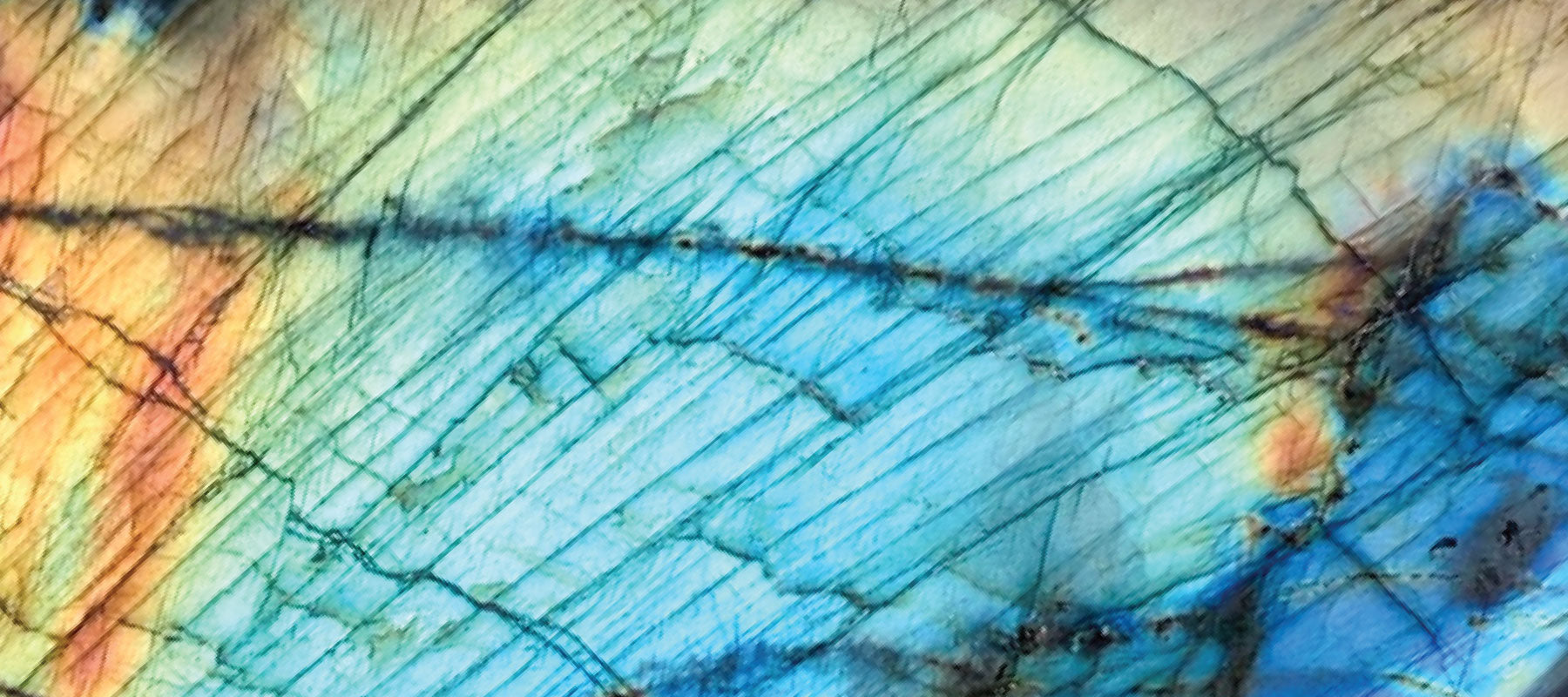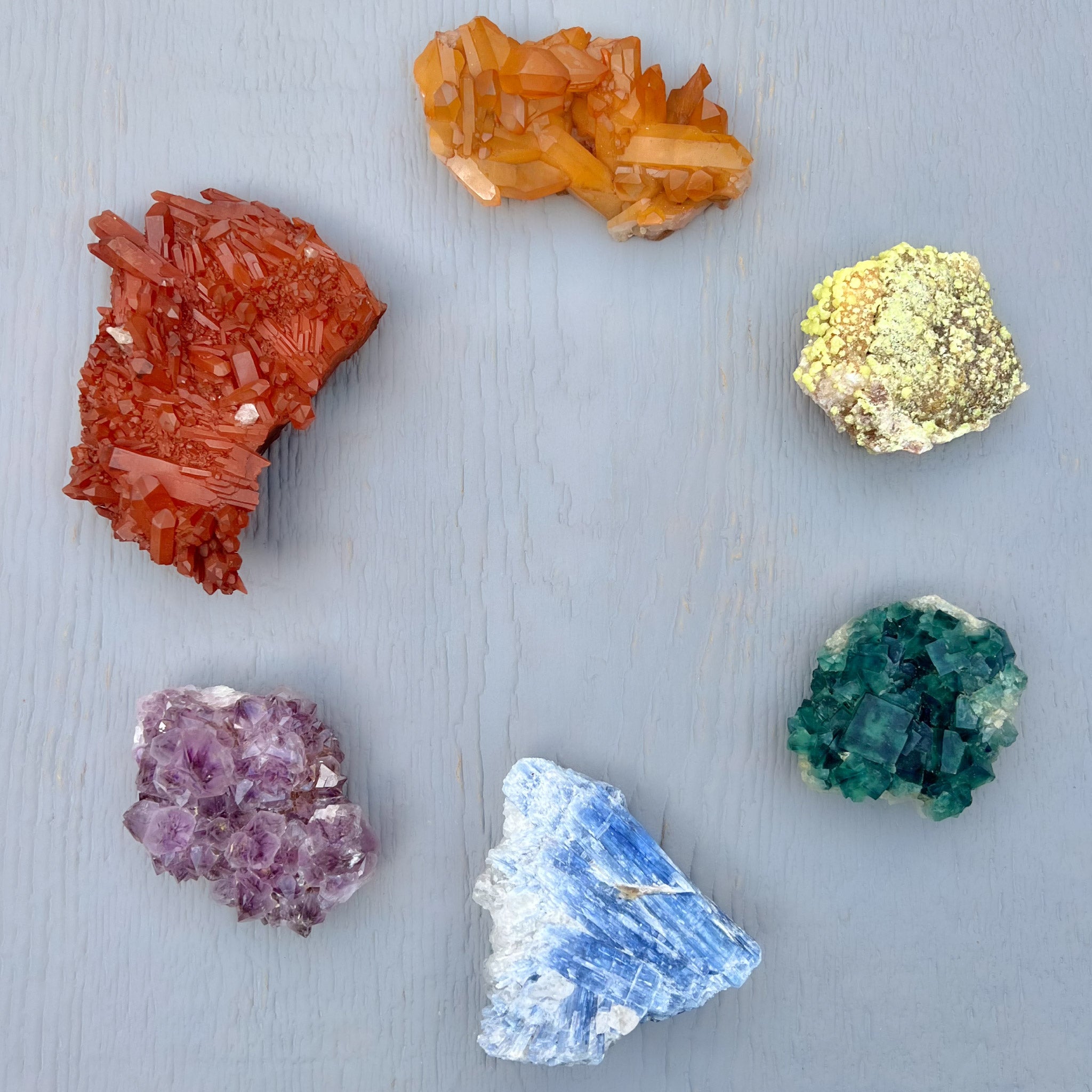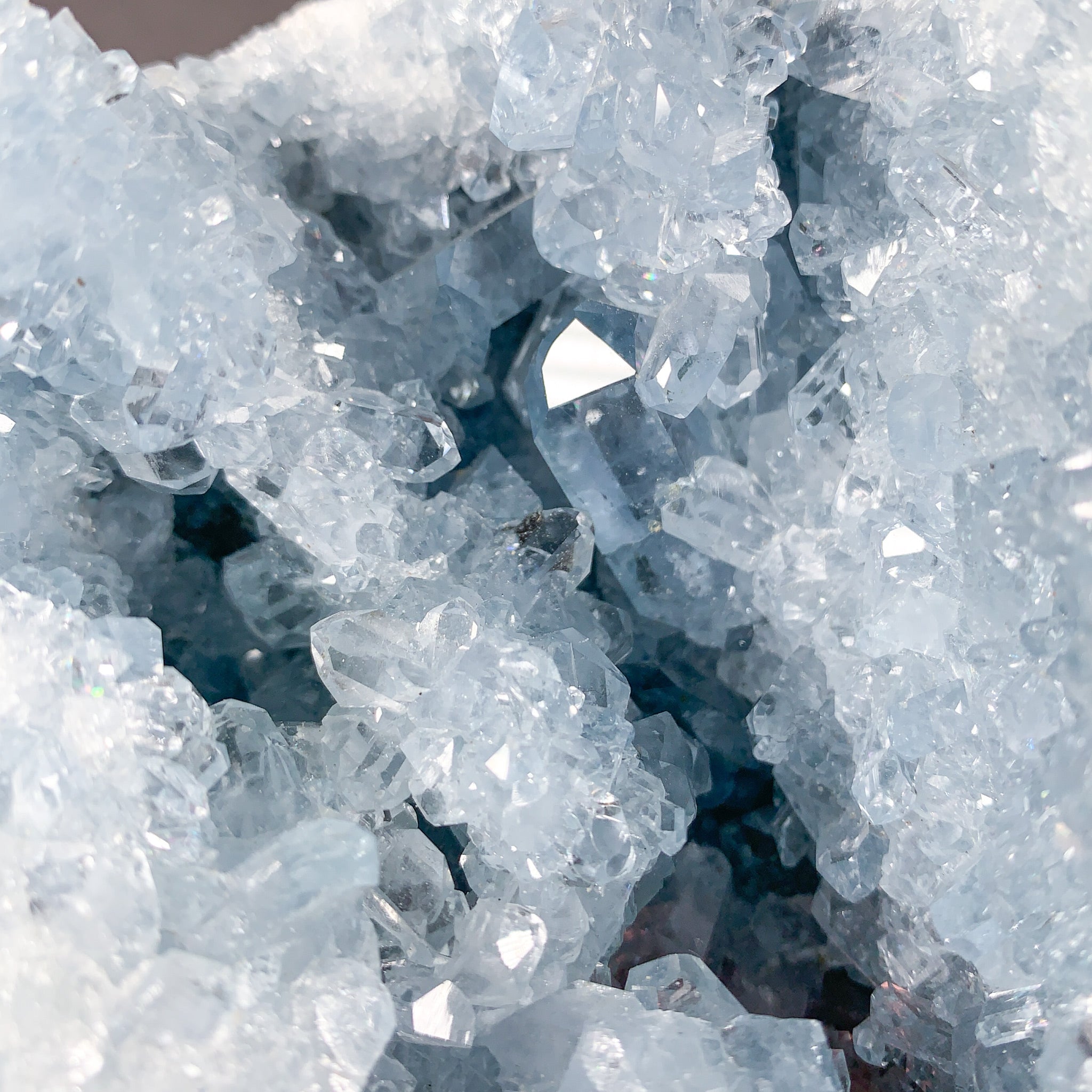In this Guide, you will learn what to look for when adding a new rock, fossil or crystal to your collection. We'll help you identify what makes a "good" specimen, and also how to recognize a reputable seller. Follow these tips on what to look for when buying your next geologic goodie!
Introduction
At Unearthed, we believe in our motto "A Stone For Every Home". To us that means more than just bringing you incredible crystals and fossils at a fair price. It also means sharing our geologic knowledge with you!
Adding a new piece to your collection doesn't require a Geology degree. But educating yourself as to what makes certain specimens so unique, and also who is selling them to you can help avoid stressful shopping situations in the future.
We love our customers and are happy to answer any questions you have when adding a new piece to your collection.
Where to Buy
If you're looking to buy a new crystal or fossil for your collection, you're in the right place. At Unearthed, we have so many unique pieces to choose from right here!
If you're planning on shopping around a bit, or buying from someone new, this Guide will help you identify where to shop, what to look for, and who might be a safer person to shop with.
Buying In Person
Local rock shops, festivals, farmer's markets and gem shows are great places to meet other rock and fossil enthusiasts face to face. When buying in person, you can physically see the product, AND you get to interact directly with the seller. This is a great opportunity to ask questions and receive real-time responses about the piece you are interested in buying. You can also determine if the dealer is knowledgable about the products they are selling. Would you buy a new bicycle from someone who doesn't ride a bike? Probably not. Check to make sure the seller is knowledgeable about their products.
Watch Out for Dishonorable Sellers
Some vendors will tell you ANYTHING to get you to buy a piece, even if it is not always truthful. I have seen many people get tricked into buying pieces that a vendor said were "natural" but were actually dyed, dipped, or heat treated to change the color. That does not mean there is something "wrong" with that piece, but the buyer should 100% be disclosing these things to you.
Keep an Eye Out for Trick Pricing
You must also be aware of trick pricing. A vendor may offer you deep discounts, or say "everything is 50% off" when in reality, they have marked the items up so astronomically high, that even with a 50% discount you are still overpaying!
Just like shopping for clothes, household products, etc. doing some research ahead of time will help get you prepared, and this Guide is a great place to start!
Pros to Buying in Person
You can physically see and possibly hold the specimen to examine its quality and characteristics. You can talk to the vendor to get a feel for their integrity, knowledge, and passion for the products they are selling. Sharing mutual excitement for rocks and fossils face to face is really fun! Trust me, if you met me in person, you'd see just how hard I nerd out on Geology :D
Cons to Buying in Person
Potentially limited selection of material at smaller venues like rock shops and festivals. Gem shows offer a much wider selection of material but can bring some less than honorable individuals to the selling table. These shows can also be overwhelming because of the volume of material available. There may also be a host of different vendors selling very similar things for very different prices, each with different "Grades" (we'll get to that shortly).
Buying Crystals and Fossils Online
Options for buying crystals and fossils online include Etsy, eBay, individual websites (like us!) or on social media.
Pros to Buying Online
You don't have to leave the couch! You can shop in the comfort of your own home (or at work....we won't tell). There is literally an endless sea of crystals and fossils to choose from. Good product descriptions will instantly educate you as to what makes each specimen unique, provide nice photographs and product dimensions.
You can shop around at the click of a button and get very specific with your search. Say you need an Amethyst crystal that is 6-inches high from Uruguay. One quick search and you might have 100 different options!
Cons to Buying Online
Buying online is like a cornucopia of geologic goodies. There may even be TOO many options to choose from. Because of e-commerce advancements, it's now possible for literally ANYONE to sell online, and it seems like everybody and their brother is online selling crystals now. It can be difficult to tell if a dealer actually cares or knows anything about the items they are selling, or if they are just out to make a quick buck.
Watch Out for Over-Altered Photos
Some sellers alter their product photos to such an extent that an item may look amazing online but once you receive the product in person it is actually quite dull or not as advertised.
It's also sometimes difficult to “connect” with a seller if you can’t get prompt responses to your questions or they do not respond to emails or DM's.
How to Identify a Reputable Seller and What to Watch Out For
While options for finding and buying crystals are now practically endless, identifying an honest and trustworthy seller may be harder now than ever. But how do you know who is safe to buy from and who isn't?
Knowledge, Passion, and Interaction is Key
Does the seller seem knowledgable? If they struggle to answer your questions directly, or don't answer you at all, that's a red flag! If the seller cannot explain to you why something is rare, special, or defend the pricing of an item, take note.
Questions to Ask Yourself:
- Do you have pleasant interactions with this seller?
- Are they responsive to your questions, comments and seem to genuinely care about you as a buyer?
- Are they passionate about the products they are selling and eager to share that love with you?
- Do they have good product descriptions, dimensions and photographs?
Do Some Research, and ASK QUESTIONS!
If you are thinking about buying from someone new, do a little research. Do they have an About page on their website? If the About page is non-existent or doesn’t really tell you who they are or why they care about rocks or fossils, they may not be the best place to buy from.
Do your research, and don't be afraid to compare prices online. Just keep in mind, each geologic goodie is like a snowflake. Pieces may look similar, but even tiny differences in quality can actually make a huge difference in price. So don't be afraid to ask your prospective seller if you have questions! If they are good at what they do and care about you as a buyer, they will be happy to respond and set your mind at ease.
Another great way to know a good seller is word of mouth. Has a friend purchased from them and had a good experience? That’s a great sign! Are they enthusiastic and eager to share with you and educate you on what you are buying and why it is so special? That’s a good seller in my book.
How to Select a New Piece for Your Collection
You’ve probably heard it before, "Just use your intuition"!
But what does that really mean? You might be saying to yourself "Ok Lori, so I just walk into a rock shop or click on a rock shop online and see what I’m drawn to?” The short answer is "Yes".
There are some mineral and fossil types that I am just naturally attracted to. If you've been following me for awhile, you probably know I love the mineral Azurite. I also really like Trilobite fossils. But on any given day, some crystal I may have not paid much attention to before catches my eye, and that’s really exciting!
Look around and see what you are gravitating towards. Are you attracted to a certain color? Maybe a shape? Do you want it to “do” something for you energetically? Or maybe you know EXACTLY what you want: “I need a large crystal cluster to fit on my mantle and that’s it.” All of those things will help you narrow it down.
What Makes a “Good” Specimen?
Here are some factors to consider when purchasing a new piece for your collection:
- Color - Is the crystal or fossil color just knocking your socks off? Is the color “normal” for that type of mineral or fossil? Do you want it because it’s textbook color for that variety (purple Amethyst for example) or do you want it because it’s so unusual for it to be that color (Amethyst with red-iron inclusions)? Are there nice photos or videos depicting the piece? Has the color been enhanced on the photo or was the seller able to capture the "true" color.
Sometimes color may not be a factor, especially when selecting a piece that is naturally clear or colorless. In that case, move on to clarity!
-
Clarity - The clarity is a measure of how “clear” the specimen is, or how easily light transmits through it. Is it opaque or translucent? The clarity of a crystal often matters more when selecting gemstones for jewelry, but may not be a factor for selecting mineral specimens. For example, some stones are naturally more opaque than others, so you may not find them with good clarity and that's ok! Many crystals also have inclusions in them from other minerals or secondary crystal growth. You may want your crystal to be extra clear for a Quartz specimen for example, but a Black Tourmaline will never show that type of clarity which is typical for that species. When in doubt, ask the seller.
-
Shape - Is it classic for that mineral or fossil type to look a certain way? Again, ask your seller if it’s normal, or unusual in some way. Are the crystals supposed to form in a mass, or a cube, or a point, or what? Don't be afraid, and ASK YOUR SELLER :)
-
Size - Is it “supposed” to be small, or large? Is it more rare to be one size or another. Are the dimensions of the piece listed in the description? A good seller will list product dimensions. It is sometimes difficult to determine the size of a piece just from a photo, so check those dimensions in the product descriptions!
-
Age - This applies more to fossils than minerals or crystals. I get asked all the time if the age of the fossil makes it more valuable / more expensive. The answer is not necessarily. Just because something is old does not mean it is rare and therefore more valuable. There are Trilobite fossils out of Morocco that are over 400 million years old! But they are so commonly found that the price could be under $20 just because they are so abundant.
- Location - Some minerals and fossils only occur in certain places geologically but some rock formations just don’t have the right geologic environment to produce certain minerals or fossils.
While living in Florida, I could find fossilized shark teeth with relative ease. Here in Colorado, shark teeth fossils are MUCH harder to find, but there are lots of great crystals like Smoky Quartz, Amazonite and Topaz that I would have never been able to find in Florida. It's all about having the right geologic environment to produce certain crystals or fossils.
That being said, if it’s less common to find something from a certain location, the price may “seem” more expensive because of its rarity. Which brings us into our next topic….RARITY!
- Rarity - Supply and demand. Rarity has to do with all the factors listed above plus how abundant that specimen is. If something is not commonly found, or is very unusual for that particular location, the price may increase.
Take Tourmaline for example, it is not a very abundant mineral geologically, especially compared to other minerals like Quartz or Fluorite. However, there are certain locations in the world where Tourmaline is more commonly found than others. Some absolutely fabulous specimens have been found in Brazil.
Tourmaline from California, is also stunning, but much more uncommon than from Brazil. Because of this, a California Tourmaline could be considered more rare, and therefore demand a higher relative price than something from a more common location.
It doesn’t make one better or worse, it’s just different! So don’t be afraid to ask your dealer about the location, quality, or rarity.
- Grading Crystals and Fossils
No, it's not how well the crystal or fossil performed in school, it's about the "quality" of the piece. Some dealers classify their specimens by Grade. They may use terms like "Extra Quality", "Grade A+" and so on. These grades can vary from A-D and are a classification of what the seller thinks are the best of the best and down from there.
If the crystal or fossil is in excellent shape, has no breaks, scratches or flaws, it would likely be considered Grade A or Extra Quality. If there are some minor issues, it might be Grade B or lower. Again, don't be afraid to ask your seller what these designations mean. For some massive pieces like Rose Quartz chunks, the "Grade A+" or "Extra Quality" pieces are all about the color saturation. If it's a good seller, they won't have any trouble telling you the difference between the classifications.
How Do I Know if It's a Fair Price?
Prices are typically dictated by all of the factors we just discussed above, so it is important to educate yourself before buying from someone new. Are they marking their prices fairly? Is there a reason a piece is marked higher than somewhere else you might have seen online. As we have said, don’t be afraid to ask. A reputable seller will be happy to explain to you what makes a certain piece more valuable than another.
How Do I Know If a Crystal or Fossil Is Real?
First things first, the seller should 100% disclose to you, the buyer, whether or not the piece is man-made, enhanced in any way, repaired, dyed, dipped, heat treated etc.
If you are new to collecting, this is why it is SO important to buy from a reputable source.
Some crystals are man-made, and some have been dyed, dipped, or heat treated to a different color.
Some may have been dipped in a chemical solution to create "aura" crystals. Some crystals or fossils may have been broken over geologic time and required some repair work by gluing them back together. That does not mean something is "wrong" with the specimen. This happens naturally, especially with fossils that are millions of years old. Just make sure the seller discloses these things to you. When in doubt, just ask!
Closing Thoughts
So in closing, the most important questions to ask yourself:
- Do you like it?
- Are you buying from a reputable source?
- What makes it special?
Maybe what you are looking to buy just isn’t that rare and unique but you like it just the way that it is. That's perfect! Knowing up front what you are drawn towards is a great place to start when adding a new piece to your collection.
Quartz for example, is one of the most common minerals on earth. Does that mean that just because Quartz is common that it can’t also be rare? Nope! There are TONS of varying factors like those we just discussed that can make Quartz specimens worth thousands of dollars if not more. So don’t be afraid to ask the seller questions to find out what makes something so special. And if you're ready to shop, start here!




